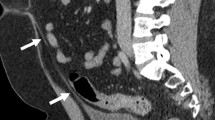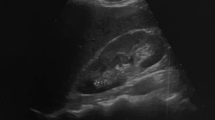Abstract
The possible role of well-assessed radiological parameters in the prediction of ureteral stricture formation in cases with impacted obstructive ureteral calculi has been evaluated. 46 adult patients with or without ureteral stricture formation after ureteroscopic stone management were included. In addition to stone size and some certain radiological parameters including ureteral wall thickness (UWT) of the involved ureter at the impacted stone site was also measured and noted on computed tomography (CT) images. Parameters were evaluated in two subgroups of cases, namely: Group 1: patients in whom a ureteral stricture formed after endoscopic stone removal and Group 2: patients normal ureteral anatomy without any stricture formation. The possible relationship between the UWT values and degree of hydronephrosis (HN) with subsequent stricture formation was comparatively evaluated. All of the stones were proximal ureteral calculi in both groups. Both the degree of HN and proximal ureteral diameter (PUD) parenchymal was higher in cases with stricture formation. In addition, mean parenchymal thickness was lower and mean values of UWT measurements at the stone site were 3.70 ± 0.97 mm and 2.17 ± 0.26 mm in Groups 1 and 2, respectively. A cutoff value 2.49 mm for UWT was found to be highly predictive for stricture formation. UWT value calculated at the obstructing stone site was found to be predictive enough for the likelihood of ureteral stricture formation with high sensitivity and specificity . This evaluation along with some other radiological parameters may enable the urologists to follow such cases on this aspect with necessary measures taken.


Similar content being viewed by others
Data availability
Not applicable
References
Scales CD, Smith AC, Hanley JM, Saigal CS (2012) (2012) Prevalence of kidney stones in the United States. Euro Urol. 62(1):160–165. https://doi.org/10.1016/j.eururo.2012.03.052. (Epub 2012 Mar 31)
Curhan GC (2007) Epidemiology of stone disease. Urol Clin N Am 34:287–293. https://doi.org/10.1016/j.ucl.2007.04.003
Sunaryo PL, May PC, Holt SK et al (2023) Ureteral strictures following ureteroscopy for kidney stone disease: a population-based assessment. Euro Urol. 83(6):e161–e162. https://doi.org/10.1016/j.eururo.2023.01.030
May PC, Hsi RS, Tran H et al (2018) The morbidity of ureteral strictures in patients with prior ureteroscopic stone surgery: multi-institutional outcomes. J Endourol 32(4):309–314. https://doi.org/10.1089/end.2017.0657
Sammon JD, Ghani KR, Karakiewicz PI, Bhojani N, Ravi P, Sun M, Sukumar S, Trinh VQ, Kowalczyk KJ, Kim SP, Peabody JO, Menon M, Trinh QD (2013) Temporal trends, practice patterns, and treatment outcomes for infected upper urinary tract stones in the United States. Eur Urol 64(1):85–92. https://doi.org/10.1016/j.euro.2012.09.035
Al-Abd AS, Suliman MG, Abo Farha MO et al (2014) The development of ureteric strictures after ureteroscopic treatment for ureteric calculi: a long-term study at two academic centres. Arab J Urol 12:168–172. https://doi.org/10.1016/j.aju.2013.11.004. (Epub 2013 Dec 11)
de la Rosette J, Denstedt J, Geavlete P et al (2014) The clinical research office of the endourological ureteroscopy global study: indications, complications, and outcomes in 11,885 patients. J Endourol 28(2):131-139.8. https://doi.org/10.1089/end.2013.0436. (Epub 2013 Dec 17)
Schuster TG, Hollenbeck BK, Faerber GJ, Wolf JS (2001) Complications of ureteroscopy: analysis of predictive factors. J Urol 166:538–540. https://doi.org/10.1016/s0022-5347(05)65978-2
Roberts WW, Cadeddu JA, Micali S, Kavoussi LR, Moore RG (1998) Ureteral stricture formation after removal of impacted calculi. J Urol 159(3):723–726. https://doi.org/10.1016/S0022-5347(01)63711-X
Yamaguchi K, Minei S, Yamazaki T, Kaya H, Okada K (1999) Characterization of ureteral lesions associated with impacted stones. IntJ Urol 6:281–285. https://doi.org/10.1046/j.1442-2042.1999.00067.x
Yoshida T, Inoue T, Omura N, Okada S, Hamamoto S, Kinoshita H, Matsuda T (2017) Ureteral wall thickness as a preoperative indicator of impacted stones in patients with ureteral stones under going ureteroscopic lithotripsy. Urology 106:45–49. https://doi.org/10.1016/j.urology.2017.04.047
Sarica K, Eryildirim B, Akdere H, Camur E, Sabuncu K, Elibol O (2019) Could ureteral wall thickness have an impact on the operative and post-operative parameters in ureteroscopic management of proximal ureteral stones? Actas Urol Esp 43(9):474–479. https://doi.org/10.1016/j.acuro.2018.10.003
Elibol O, Safak KY, Buz A, Eryildirim B, Erdem K, Sarica K (2017) Radiological noninvasive assessment of ureteral stone impaction into the ureteric wall: a critical evaluation with objective radiological parameters. Investig Clin Urol 58(5):339–345. https://doi.org/10.4111/icu.2017.58.5.339
Tuerxun A, Batuer A, Erturhan S, Eryildirim B, Camur E, Sarica K (2017) Impaction and prediction: does ureteral wall thickness affect the success of medical expulsive therapy in pediatric ureteral stones? Urol Int 98(4):436–441. https://doi.org/10.1159/000453668
Sarica K, Eryildirim B, Sahin C, Sabuncu K, Cetinel C, Narter F (2016) Impaction of ureteral stones into the ureteral wall: is it possible to predict? Urolithiasis 44(4):371–376. https://doi.org/10.1007/s00240-015-0850-9
Turk CNA, Petrik A, Seitz C et al (2020) Guidelines on urolithiasis.https://uroweb.org/guideline/urolithiasis/. Accessed 1 Aug 2023
Schoenthaler M, Wilhelm K, Kuehhas FE, Farin E, Bach C, Buchholz N, Miernik A (2012) Postureteroscopic lesion scale: a new management modified organ injury scale evaluation in 435 ureteroscopic patients. J Endourol 26(11):1425–1430. https://doi.org/10.1089/end.2012.0227
Mokhmalji H, Braun PM, Martinez Portillo FJ, Siegsmund M, Alken P, Kohrmann KU (2001) Percutaneous nephrostomy versus ureteral stents for diversion of hydronephrosis caused by stones: a prospective, randomized clinical trial. J Urol 165(4):1088–1092 (PMID: 11257644)
Ulvik Ø, Harneshaug J-R, Gjengstø P (2021) Ureteral strictures following ureteroscopic stone treatment. J Endourol 35(7):985–990. https://doi.org/10.1089/end.2020.0421. (Epub 2020 Oct 21)
Preminger GM, Tiselius HG, Assimos DG, Alken P, Buck C, Gallucci M, Knoll T, Lingeman JE, Nakada SY, Pearle MS, Sarica K, Turk C, Wolf JS Jr, Panel EANG (2007) Guideline for the management of ureteral calculi. J Urol 178(6):2418–2434. https://doi.org/10.1016/j.juro.2007.09.107
Yoshida T, Inoue T, Omura N, Okada S, Hamamoto S, Kinoshita H, Matsuda T (2017) Ureteral wall thickness as a preoperative indicator of impacted stones in patients with ureteral stones under- going ureteroscopic lithotripsy. Urology 106:45–49. https://doi.org/10.1016/j.urology.2017.04.047
Yamashita S, Kohjimoto Y, Iguchi T, Nishizawa S, Kikkawa K, Hara I (2019) Ureteral wall volume at ureteral stone site is a criti- cal predictor for shock wave lithotripsy outcomes: comparison with ureteral wall thickness and area. Urolithiasis. https://doi.org/10.1007/s00240-019-01154-w
Yoshida T, Inoue T, Taguchi M, Omura N, Kinoshita H, Mat-suda T (2019) Ureteral wall thickness as a signifcant factor in predicting spontaneous passage of ureteral stones of </= 10 mm: preliminary repo. World J Urol 37(5):913–919. https://doi.org/10.1007/s00345-018-2461-x
Sahin C, Eryildirim B, Kafkasli A, Coskun A, Tarhan F, Fay-daci G, Sarica K (2015) Predictive parameters for medical expulsive therapy in ureteral stones: a critical evaluation. Urolithiasis 43(3):271–275. https://doi.org/10.1007/s00240-015-0762-8
Sarica K, Kafkasli A, Yazici O, Cetinel AC, Demirkol MK, Tuncer M, Sahin C, Eryildirim B (2015) Ureteral wall thickness at the impacted ureteral stone site: a critical predictor for success rates after SWL. Urolithiasis 43(1):83–88. https://doi.org/10.1007/s00240-014-0724-6
Author information
Authors and Affiliations
Contributions
KS: project development and manuscript writing. CS: project development and manuscript YK: data collection. writing. RS: data collection and manuscript writing. OA: data collection. FB: data collection. MU: data collection. EBS: data collection.
Corresponding author
Ethics declarations
Conflict of interest
The authors have no conflict of interest to declare.
Ethical approval
This retrospective study was conducted after receiving approval from the institutional review board.
Additional information
Publisher's Note
Springer Nature remains neutral with regard to jurisdictional claims in published maps and institutional affiliations.
Rights and permissions
Springer Nature or its licensor (e.g. a society or other partner) holds exclusive rights to this article under a publishing agreement with the author(s) or other rightsholder(s); author self-archiving of the accepted manuscript version of this article is solely governed by the terms of such publishing agreement and applicable law.
About this article
Cite this article
Sahin, C., Karaca, Y., Sobay, R. et al. Ureteral stricture formation after endoscopic removal of obstructing stones: could it be predicted with well-assessed radiological parameters?. Urolithiasis 52, 34 (2024). https://doi.org/10.1007/s00240-024-01530-1
Received:
Accepted:
Published:
DOI: https://doi.org/10.1007/s00240-024-01530-1




